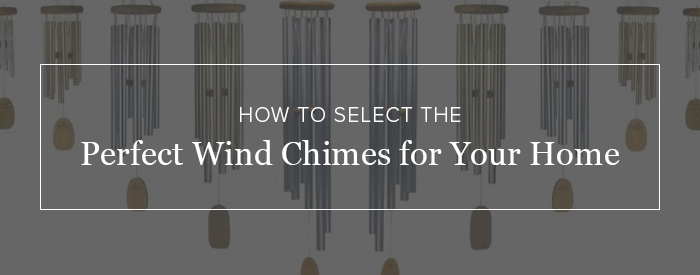
Magical enough to inspire an entire song by Brian Wilson, wind chimes have long soothed the mind and heart of humans — they create a range of experiences for us. Crafted by man and played by the breeze, they can alternately provide a subconscious backdrop or be the focal point of your concentration.
Wind chimes can create an atmosphere of whimsy or one of nostalgia, conjuring every sentiment from childhood joy to the splendor of a cathedral. Wind chimes can create a light, delicate tinkling or sound like loud church bells. In knowing how to choose wind chimes, you are giving yourself the gift of music. Picking wind chimes for your home gives you the ability to create your own sound.
Wherever you happen to be in the world, you’ll feel like you’re back at home if you happen to hear that tone.
You can create almost any mood you want to achieve with wind chimes. If you’re interested in creating a sonic landscape around your home, wind chimes can help you accomplish that. In this article, we’ll arm you with knowledge on how to craft your own wind chime aesthetic using the following parameters:
- Purpose of wind chimes
- Different styles available
- Wind chime materials and the sounds they produce
What Are Wind Chimes For?
Wind chimes are a versatile sonic and visual tool. In modern society, we occasionally fail to recognize the power they hold in transforming space and mood.
In fact, wind chimes have been around for thousands of years. One of the earliest known sets of wind chimes dates back over 3000 years in ancient China. Perhaps due to the purity of their tone, wind chimes and bells were thought to spread good fortune and peace. The ancient Japanese used bells to keep evil away. Today, part of the spirit of their early powers stay with us.
Specifically, wind chimes can have several uses in today’s world, including to:
- Connect With the Outdoors: There is a sense of interaction with the outside world that occurs when wind chimes blow. Naturally, the most common use of wind chimes is to harness this sense of connectedness. People hang windchimes near windows and doors, where the sound of the wind tinkling the chimes reminds them of the natural world outside. For many people, wind chimes have an association with an oncoming thunderstorm or a cool summer breeze.
- Relieve Symptoms of Anxiety: It’s true — wind chimes can have a profound effect on those who suffer from anxiety. The sound of gently singing chimes plucked by the breeze can alleviate feelings of anxiousness in certain people. For this situation, it is essential to take time in selecting the wind chimes that trigger a positive response in you. For some people, this will be high and tinkling, while deeper and more resonant tones may be more calming for others.
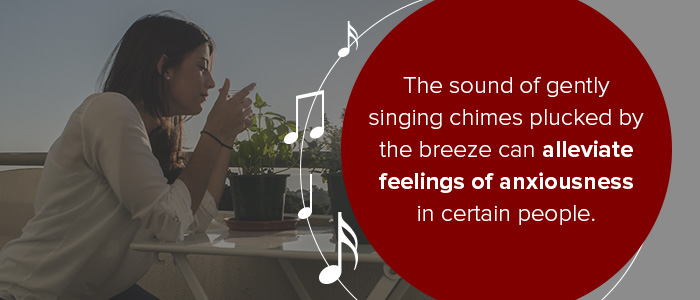
- Boost Your Home’s Appearance: There is no doubt that wind chimes look as beautiful as they sound — why else would some people hang them up indoors, where there is no wind? Wind chimes come in several different materials, as we will soon discuss. Depending on the shape and color scheme you’re after, you can customize your wind chimes to create a particular aesthetic and complement your home.
- Keep Birds Away: Birds provide us with beautiful music of their own, but let’s just say they can be messy guests when they feel too at home on our porches. A set of wind chimes is highly effective at startling birds who to cozy up too close to your home.
- Serve as Spiritual Tools: Bells and chimes play a significant role in Buddhism and Feng Shui. In Buddhism, bells play a role in honoring the Three Treasures: the Buddha, Dharma and Sangha. The people ring bells during or just before beginning meditation, which is said to bring divine protection and clarity of the mind. In Feng Shui, they are used as a means of directing positive chi energy to different parts of the home. People of these beliefs still honor these uses today, which is why you can find wind chimes in many different parts of the world.
- Make a Home More Welcoming: It’s hard to imagine a more welcoming gesture than a house that sings with the wind. Many people will suspend wind chimes near where people enter — the porch or front door, for instance — so that music will surround whoever visits your home.
The Anatomy of Wind Chimes
We can describe wind chimes by analyzing their separate parts and parameters, including the following:
- Ring Hook: The very top of the wind chime will feature a ring hook. All of the strings running down to the ring itself will attach to this loop, which should be made of metal or thoroughly knotted string.
- Top Strings: These synthetic cords are made to be durable for outdoor use. They must withstand wind, water and ultraviolet radiation.
- Top Piece: The top piece is generally a ring from which the wind chimes hang. It can be made of wood, metal or plastic.
- Tube Strings: Generally made from the same material as the top strings, these suspend the wind chimes from the top piece. They are set to allow the striker to hit the tubes where they will resonate the most.
- Tubes: Wind chime tubes may be made from aluminum, steel, bamboo, glass, wood or similar material. They can also come in a variety of finishes and colors, and the type of material determines the timbre of the note.
- Striker: Also made from a variety of materials, this is the part that strikes the chimes and produces a tone.
- Sail: The sail hangs below the striker, and the wind catches it to move it.
Styles of Wind Chimes
To begin our discussion of various parameters available, we will first discuss wind chimes’ visual aspects. Though best known for the beautiful music they create, half of their charm comes from the visual impact they can add to your home. Some of the various styles available are:
- Classic Rods: The timeless visual appeal of the tubular metal wind chime is sure to never lose its appeal. Made from machined metal, the chimes are metal rods that have a sustained pitch due to their solid mass. They look at home anywhere but are an especially good choice for those with modern decor. The sleek, simplistic elegance of machined metal contrasted with a smooth wooden top piece can easily complement the more minimalistic tendencies of modernism. These chimes also resist wind movement more than other types, making them a bit of a quieter option.
- Classic Tubes: Tubular wind chimes share some aesthetic properties with rods, but there are also some fundamental differences. Perhaps most noteworthy is the lighter weight of the tubes. This means less wind is required to make them sing — and because they will sing in a breeze, this also gives them a “lighter” appearance. What should you do with this information? The answer will come down to personal preference. If you’d prefer a more solid-looking wind chime that will move less, you may prefer rods. On the other hand, tubes are great for those who fancy a slightly livelier wind chime.
- Wood Pipe Wind Chimes: Wood pipe wind chimes are often made from bamboo and create an entirely different visual feel. With their natural color and lightweight nature, they are in some ways more fanciful than their metal counterparts. Wood pipes are reminiscent of pan flutes and are an excellent choice for anyone who wants to conjure up imagery of a forest. Plus, their lack of resonance makes them slightly more percussive and less sustaining.
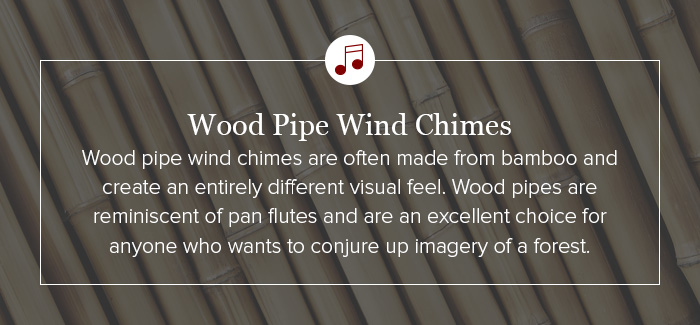
- Butterfly/Creature Wind Chimes: For those who are more interested in the visual potential of wind chimes, there are a host of options featuring butterflies, birds and other creatures as the chimes themselves. Note that these types of wind chimes do create pleasant sounds, but they’re less sonorous due to an emphasis on the shape of the chimes. These make great decor items for places like gardens, porches, patios and lining yards.
- Feng Shui Gongs: If you want to bring an East Asian flair to your home, Feng Shui wind chimes are the perfect means of doing so. These chimes come in many different shapes and sizes, from bells to miniature gongs and rods. They have a distinct sound — one that has been honed by centuries of thought regarding which tones have the most calming effect on us. Color schemes often include brass, bronze, wood tones, black and red. There is plenty of literature available on how to orient and use Feng Shui wind chimes.
- Glass/Decorative Wind Chimes: If you’ve ever witnessed the heavenly aura of glass wind chimes in the sunlight, you know the effect they can have on a space. Glass wind chimes can act as a prism, sending light of all colors dancing around the walls and floor. Additionally, their soulful, delicate sound is lighthearted and pleasant. Glass wind chimes can be used outdoors, though many people use them inside to brighten up a space and add a pop of color.
- Beads: Often referred to as gypsy wind chimes, it is common to see chimes made of beads as decorative items. While these do not produce musical notes of any particular tonality, they are fun to play with and look great indoors, in gardens or hanging on porches. Use them to add accents to funky design motifs or to add flair to a spot.
The takeaways here are:
- If you are looking to complement a modern design, first consider the simplicity and accenting potential of wind chimes made of rods or tubes.
- If your home is contemporary or traditional, you should try experimenting with rods, tubes and wood pipes.
- For homes with a unique flair, as well as for patios and gardens, look into butterfly/creatures, Feng Shui, glass/decorative and bead wind chimes.
Wind Chime Materials
The makeup of wind chimes determines their tone and sustain, and it will dramatically impact the atmosphere around your home. Here are the standard choices for wind chime material:
- Hard Metals: Anodized aluminum and steel are popular choices for wind chimes due to their durability, beautiful finish and tone. They produce a sharp sound with a short attack, much like striking the key of a glockenspiel. If they are rods, they will sustain longer than tubes. With the proper finishing, these chimes will last a long time.
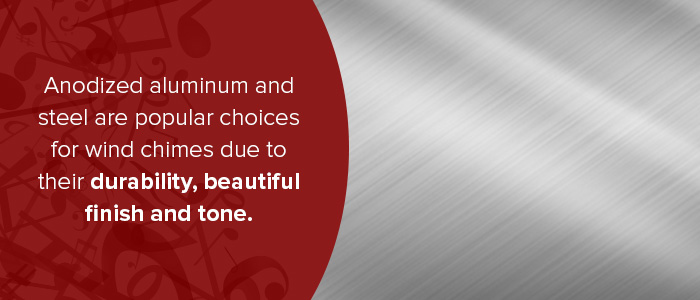
- Soft Metals: Copper is one example of a soft metal, which produces a mellower tone with a gentler approach and fewer high overtones. You can also find coated copper to help give it resistance to corrosion, though it can turn an undesirable shade of green as it oxidizes.
- Glass: While not particularly resonant, glass produces a pleasant tinkling sound that is more playful and less sonorous — the pitch tends to be higher than with metals. It is perfect for letting the wind have a light conversation with you, whereas metals feel like deeper subject matter. Glass is virtually impervious to wear and tear, though it is delicate and can break if you drop or mishandle it.
- Wood: If you’ve ever heard the sound of a wood block or marimba, a wooden wind chime is somewhere in between the two. While it does possess tonality, it is light, percussive and less prominent. However, wood is susceptible to rot from moisture, so make sure yours is coated with a stain, oil or other protectants to keep it from decaying.
Wind Chime Tunes
Wind chime notes are not random — manufacturers piece them together carefully with intentional tunes and tonalities in mind. Let’s look at some of the different wind chime tunes you can choose to personalize your sound:
- Pentatonic: The pentatonic scale is familiar to us all — even those of us who have not heard the term before. The next time you’re in front of a piano, play only the black keys to hear the pentatonic scale. The scale consists of the 1, 2, 3, 5 and 6 notes of a major scale, which are harmonious in any combination. At times, they can even feel East Asian, making them of particular interest to those looking for Feng Shui chimes.
- Major Scale: The major scale is the “happy” scale — that is, it has a major third that is almost universally interpreted as happy or upbeat. Its seven distinct notes can create some interesting harmonic intervals, as well as the occasional dissonance to spice things up.
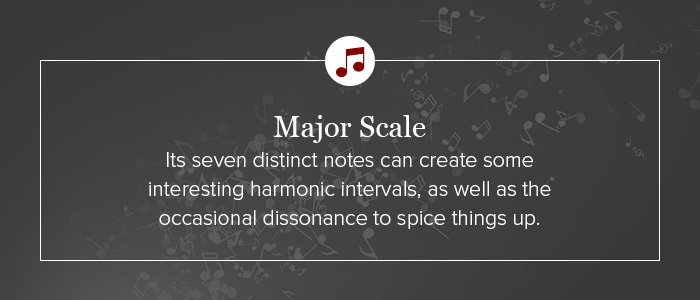
Hear the Wind Sing at www.TheMusicHouse.com
To summarize, there are several factors you should consider before you pull the trigger on your wind chimes. Make sure to give careful thought to the purpose your wind chimes will serve, the style you’re looking for, the materials and sounds you would like to hear regularly.
TheMusicHouse.com is passionate about all things music, including wind chimes. From vintage music box repair to an encyclopedic knowledge of classical, jazz, folk, country and more, music is in our blood. We will help you select wind chimes that sing just the tune you’re looking for.
We’ve got any type you could want — just take a look at our selection for proof. Contact us today for more information or to ask any questions you may have about wind chimes, as well as our other offerings.